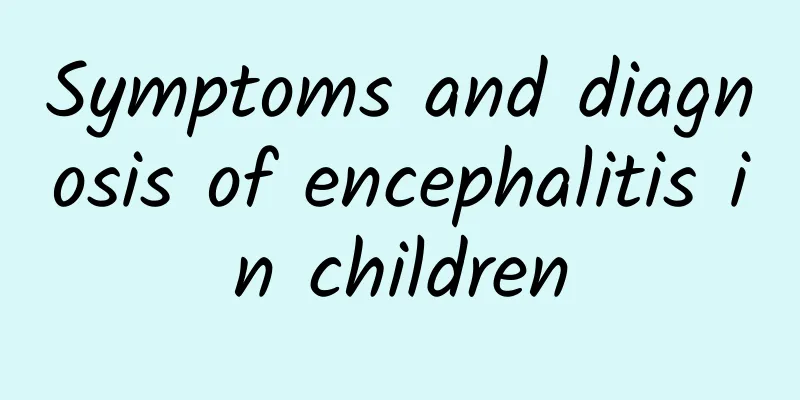Symptoms and diagnosis of encephalitis in children

|
Infants and young children are a special group that is prone to meningitis. When a child develops meningitis, they often have a persistent high fever, loss of appetite, unconsciousness, vomiting, diarrhea and other symptoms. If the condition is serious, they may suffer from prolonged confusion, shock, and even convulsions and epilepsy-like symptoms. The harm is particularly great. Symptoms of meningitis in children 1. High fever (40°C), stiff neck, severe headache, loss of appetite, confusion, vomiting, convulsions, fatigue, drowsiness, sensitivity to light, small blood spots on the skin, skin rash {especially in the armpits, hands, and feet}. These symptoms of meningitis are similar to those of a cold and are often the cause of misdiagnosis. Symptoms may change within one to two days, and some may become life-threatening within hours. 2. In infants and newborns, high fever, headache, and stiff neck are not typical symptoms, and sometimes low temperature may occur instead. The symptoms experienced by this group of patients include: high-pitched and continuous crying, unusual drowsiness, poor appetite, extreme sensitivity, and some having swollen fontanelles. 3. The above symptoms may or may not appear, but they will show latent symptoms such as confusion and dullness. 4. Severe bacterial meningitis may also cause symptoms such as shock, coma or convulsions {similar to epilepsy}. Meningitis test for children 1. Blood picture: In the acute phase, the peripheral white blood cell count increases significantly, with neutrophils being the main cells and immature cells may appear. 2. Cerebrospinal fluid: The fluid pressure is increased, and the appearance is turbid and pus-like. The white blood cell count is between 1,000 and 10,000/mm[3], and in a few cases it is higher. Neutrophils predominate and can account for more than 90% of the total white blood cell count. Sometimes pus cells accumulate in lumps, and smears and pathogenic bacteria cultures are often positive. Occasionally, the first lumbar puncture is normal, but a follow-up examination a few hours later turns purulent. The protein content increases, reaching over 1.0 g/L, the sugar content decreases, usually below 2.2 mmol/L, the chloride content also decreases, and the immunoglobulins IgM and IgG increase significantly. 3. Bacterial antigen determination: Commonly used methods include polymerase chain reaction, countercurrent immunoelectrophoresis, latex agglutination test, enzyme-linked immunosorbent assay, radioimmunoassay, etc. 4. Other optional examinations: including blood routine, blood electrolytes, blood sugar, urea nitrogen, and urine routine. 5. X-ray examination: Chest X-ray is particularly important for patients with purulent meningitis, as it can reveal pneumonia lesions or abscesses. Plain films of the brain and sinuses can reveal skull osteomyelitis, paranasal sinusitis, and mastoiditis, but CT examinations of the above lesions are clearer. 6. CT and MRI examinations: CT or brain MRI examinations may be normal in the early stages of the disease. When there are neurological complications, abnormal manifestations such as ventricle enlargement, narrowing of cerebral sulci, brain swelling and brain shift may be seen. Ependymitis, subdural effusion and localized brain abscess may also be found. Enhanced MRI scans are more sensitive than enhanced CT scans for diagnosing meningitis. MRI scans can show meningeal infiltration and cortical reactions. With appropriate technical conditions, venous occlusion and infarction in the corresponding area can be demonstrated. |
<<: What are the sequelae of encephalitis?
>>: What causes viral encephalitis?
Recommend
Causes of sallow complexion
You often hear people describe some very thin peo...
Can spastic paraplegia be treated? Four methods are effective in treatment
We can treat spastic paraplegia. The main treatme...
8 acupoint massage techniques to get rid of minor body ailments
The typical abdominal pain of acute appendicitis ...
Folk remedies for hemorrhoids
If we sit on a stool for a long time at work, the...
How to drink Eucommia bark soaked in water
Eucommia ulmoides has the functions of nourishing...
Efficacy and function of Eclipta prostrata
Eclipta prostrata, also known as Black Eclipta pr...
Is cloudy urine normal during ovulation?
If women have turbid urine during ovulation, they...
How to quickly relieve abdominal cramps
Abdominal cramps are a common condition, which me...
What is the diet for chronic glomerulonephritis?
Chronic glomerulonephritis is abbreviated as chro...
Why is there pain when pressing on the upper chest?
Generally, pain inside the human body is caused b...
What is the reaction to having a brain tumor?
Brain tumor is a very serious tumor. Because it o...
Traditional Chinese Medicine Treatment of Herpes
Herpes is a disease caused by the herpes virus. T...
Psychological needs and adjustments of the elderly
In fact, when the elderly reach a certain age, th...
How to tell boy from girl
For pregnant women, both she and her family membe...
Danshen tablets are suitable for people
Danshen tablets are a traditional Chinese medicin...









